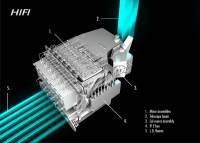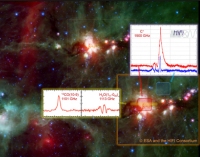Herschel's HIFI instrument ready to resume operations
18 January 2010
The HIFI instrument onboard ESA's Herschel observatory has been successfully switched on, after being inactive for more than 160 days due to an unexpected anomaly in the electronic system. This achievement brings Herschel back to its full observing capacity. HIFI was built specifically to observe water in a variety of celestial objects. Over the next three years HIFI spectra will be used to probe stellar environments and to study the role of gas and dust in the formation of stars and planets and the evolution of galaxies.
 |
|
Focal plane unit of the HIFI instrument Credit: ESA |
In case of such events HIFI has a redundant set of electronics including the LCU which provides full functionality, however before it was utilised, ESA and the HIFI consortium wanted to fully understand the cause of the problem. Following the shut down of HIFI, the consortium, joined by ESA, carried out a detailed and thorough investigation before making the necessary adaptation to software that monitors the LCU to prevent the problem from happening again.
 |
|
HIFI first light spectrum Credit: ESA and the HIFI Consortium |
HIFI was built specifically to observe water in a number of different celestial targets as part of the investigation into the role of gas and dust in the formation of stars and planets, and the evolution of galaxies. The successful activation of HIFI comes as an important target, the star forming regions of the Orion Nebula or M42, approaches the instruments field of view.
HIFI has been designed and built by a consortium of institutes and university departments from across Europe, Canada and the USA under the leadership of the Netherlands Institute for Space Research (SRON), Groningen, The Netherlands, and with major contributions from Germany, France and the USA. Consortium members are: Canada: CSA, U.Waterloo; France: CESR, LAB, LERMA, IRAM; Germany: KOSMA, MPIfR, MPS; Ireland, NUI Maynooth; Italy: ASI, IFSI-INAF, Osservatorio Astrofisico di Arcetri-INAF; Netherlands: SRON, TUD; Poland: CAMK, CBK; Spain: OAN(IGN), CAB(CSIC-INTA); Sweden: Chalmers University of Technology - MC2, RSS & GARD; OSO; SNSB, Stockholm University - SO; Switzerland: ETH Zurich, FHNW; USA: Caltech, JPL, NHSC.
